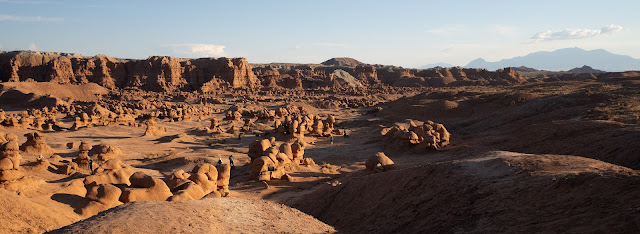Our fearless leader Caryn wasted no time. After a brief introduction, we were on our way in four-wheel-drive pickup trucks with four to a cab and supplies in the back. That afternoon, we were headed to Goblin Valley State Park. There, we wandered amongst the stone "goblins" taking numerous photographs from multiple prospectives.
We then moved to a different spot to take in the sunset and the "blue hour." These are times when photographers typically get their finest pictures. Our new spot was home to "The Three Sisters" (not to be confused with a formation of the same name outside of Provo.)
It was two days before the full moon, so the moon rose about 1 1/2 hours before the sun set. Here are "The Three Sisters" at dusk.
But wait, there's more. We continued to take pictures until after the sun set, and into the "blue hour." The "blue hour" or "magical hour" occurs just before sunrise, and just after sunset. The serene lighting makes for wonderful photography. The next picture was taken toward the end of the "blue hour." The formation is lit primarily by bright moonlight.
This image represents my first quantum leap during the workshop. Until then, I had only heard and read about merging multiple images taken at different exposure settings into one single image.
The human eye can sense a wider dynamic range of lighting than a camera. That is, the eye takes in a wider range of lights and darks. The dynamic range of a photograph can be improved by placing the camera on a tripod to keep it stationary, and obtaining multiple images with different settings. With Caryn's help, I was able to get my Sony camera to cooperate. The merging itself actually occurs later with the help of a computer.
Tomorrow is another day.






No comments:
Post a Comment
Note: Only a member of this blog may post a comment.